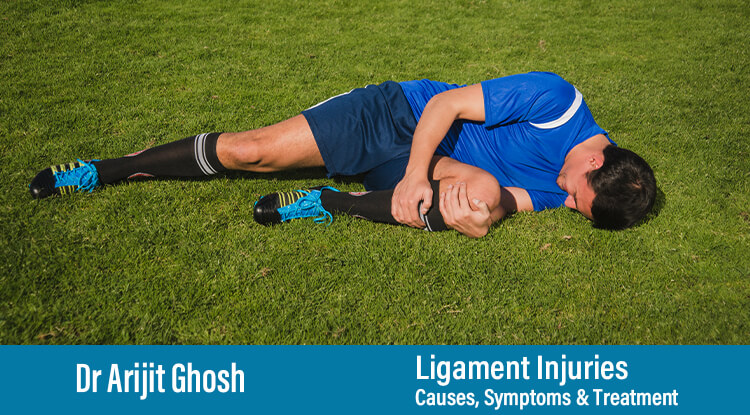Our knees bear the weight of our bodies and play a pivotal role in our mobility. However, they are also susceptible to injuries, particularly when it comes to ligaments. Knee ligament injuries can range from mild to severe, affecting individuals of all ages and activity levels. In this blog post, we’ll delve into the causes, symptoms, and treatment options for knee ligament injuries to help you better understand these common orthopedic issues.
Causes of Knee Ligament Injuries:
Knee ligament injuries often result from sudden, forceful movements or trauma that strain or tear the ligaments. The major ligaments in the knee are the Anterior Cruciate Ligament (ACL), Posterior Cruciate Ligament (PCL), Medial Collateral Ligament (MCL), and Lateral Collateral Ligament (LCL). Common causes of knee ligament injuries include:
- Sports Injuries: High-impact sports that involve sudden stops, changes in direction, or direct blows to the knee, such as soccer, basketball, and skiing, can lead to ligament injuries.
- Trauma: Accidents, falls, or collisions that exert excessive force on the knee joint can result in ligament damage.
- Twisting or Hyperextension: Awkward landings or sudden twists of the knee, especially when the foot is planted, can cause ligament sprains or tears.
- Overuse: Repetitive stress on the knee, common in activities like running or jumping, can contribute to wear and tear on the ligaments over time.
Symptoms of Knee Ligament Injuries:
Identifying the signs of a knee ligament injury is crucial for timely intervention. Symptoms may vary depending on the severity of the injury, but common indicators include:
- Pain: Sudden or gradual onset of pain, often at the site of the injury, is a key symptom. The pain may range from mild to severe.
- Swelling: Swelling around the knee joint is a typical response to ligament injuries, indicating inflammation.
- Instability: A feeling of instability or “giving way” in the knee, especially during weight-bearing activities, may signal ligament damage.
- Limited Range of Motion: Difficulty bending or straightening the knee fully is common with ligament injuries.
- Popping Sound: Some individuals may hear or feel a popping sensation at the time of the injury, suggesting a tear in the ligament.
Treatment Options for Knee Ligament Injuries:
The approach to treating knee ligament injuries depends on the type and severity of the injury. While mild sprains may heal with conservative measures, more severe tears may require surgical intervention. Here are common treatment options:
- Rest and Ice: Initially, it’s essential to rest the affected knee and apply ice to reduce swelling. This helps manage pain and inflammation in the early stages of the injury.
- Compression and Elevation: Wrapping the knee with a compression bandage and keeping it elevated can further reduce swelling.
- Physical Therapy: Rehabilitation through physical therapy is often recommended to strengthen the muscles around the knee, improve stability, and restore range of motion.
- Bracing: Depending on the severity of the injury, wearing a brace may provide support to the knee and limit movement during the healing process.
- Pain Medications: Over-the-counter or prescription pain medications may be used to manage pain and discomfort.
- Surgery: In cases of severe ligament tears, especially involving the ACL, surgical reconstruction may be necessary. This typically involves using a graft to replace the damaged ligament.
- Post-Surgery Rehabilitation: Following surgery, a structured rehabilitation program is crucial for a successful recovery. This involves progressive exercises to regain strength, flexibility, and function.
Preventing Knee Ligament Injuries:
While some knee injuries are unavoidable, certain measures can help reduce the risk:
- Warm-Up and Stretching: Always warm up before engaging in physical activities and incorporate stretching exercises to improve flexibility.
- Proper Technique: Whether in sports or daily activities, using proper techniques and body mechanics can help prevent unnecessary stress on the knee joints.
- Strength Training: Building strength in the muscles around the knee provides additional support and protection.
- Footwear: Wearing appropriate footwear, especially during sports, can enhance stability and reduce the risk of injury.
- Cross-Training: Varying your exercise routine and incorporating low-impact activities can reduce the repetitive stress on the knees.
In conclusion, understanding the causes, symptoms, and treatment options for knee ligament injuries empowers individuals to take proactive steps in maintaining knee health. If you suspect a knee ligament injury, seeking prompt medical evaluation is essential for an accurate diagnosis and the development of an effective treatment plan. Remember, a timely and comprehensive approach to rehabilitation can significantly impact the speed and success of recovery, allowing individuals to regain full functionality and return to their active lifestyles.
